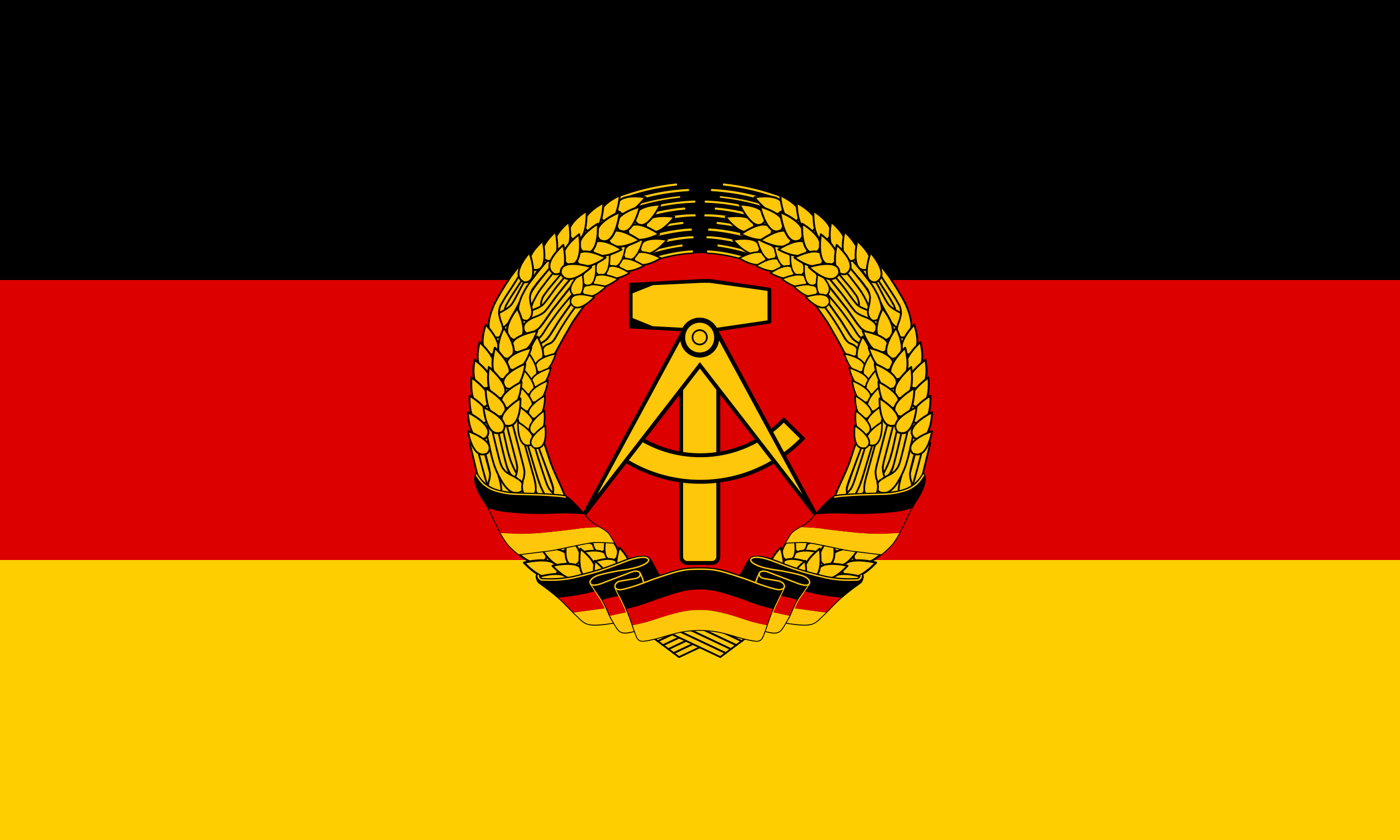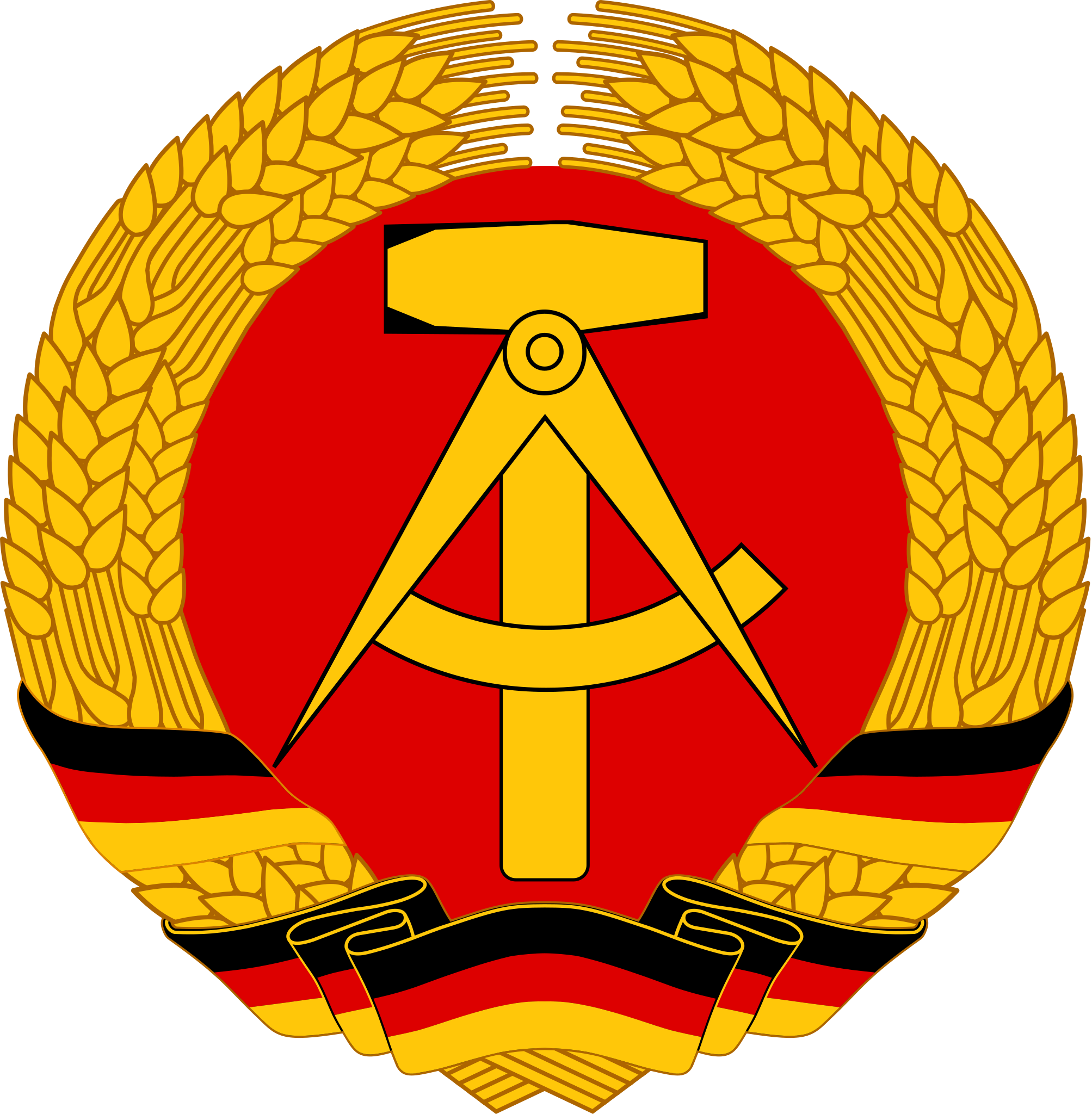German Democratic Republic (1949–1990): Difference between revisions
More languages
More actions
(Electoral system) Tag: Visual edit |
(Tourism) Tag: Visual edit |
||
| Line 61: | Line 61: | ||
As early as June 1945, newly formed [[Anti-fascism|anti-fascist]] and [[Democracy|democratic]] parties were already organizing in the Soviet occupation zone. The [[Communist Party of Germany]] (KPD) and [[Social Democratic Party of Germany|Social Democratic Party]] (SPD) united to form the [[Socialist Unity Party of Germany]] in 1946. The German People's Council was founded in 1947 and established the German Democratic Republic on 7 October 1949.<ref name=":2">{{Web citation|newspaper=[[Tricontinental]]|title=Risen from the Ruins: The Economic History of Socialism in the German Democratic Republic|date=2021-04-20|url=https://thetricontinental.org/studies-1-ddr/|archive-url=https://web.archive.org/web/20220426161306/https://thetricontinental.org/studies-1-ddr/|archive-date=2022-04-26|retrieved=2022-08-12}}</ref> | As early as June 1945, newly formed [[Anti-fascism|anti-fascist]] and [[Democracy|democratic]] parties were already organizing in the Soviet occupation zone. The [[Communist Party of Germany]] (KPD) and [[Social Democratic Party of Germany|Social Democratic Party]] (SPD) united to form the [[Socialist Unity Party of Germany]] in 1946. The German People's Council was founded in 1947 and established the German Democratic Republic on 7 October 1949.<ref name=":2">{{Web citation|newspaper=[[Tricontinental]]|title=Risen from the Ruins: The Economic History of Socialism in the German Democratic Republic|date=2021-04-20|url=https://thetricontinental.org/studies-1-ddr/|archive-url=https://web.archive.org/web/20220426161306/https://thetricontinental.org/studies-1-ddr/|archive-date=2022-04-26|retrieved=2022-08-12}}</ref> | ||
=== Counterrevolution === | |||
East Germans, who had long traveled to [[Hungarian People's Republic (1949–1989)|Hungary]], but some began using it as a way to get into [[Republic of Austria|Austria]] in the summer of 1989. On 10 August 1989, an aristocrat descended from the [[Austro-Hungarian Monarchy (1867–1918)|Austrian]] emperor incited hundreds of Germans to cross into Austria from Hungary. After Hungary broke its agreement to repatriate East Germans, the GDR ended unrestricted travel into Hungary.<ref name=":05" /><sup>:134–5</sup> | |||
== Government == | == Government == | ||
| Line 76: | Line 79: | ||
=== Electoral system === | === Electoral system === | ||
Unlike West Germany, the GDR allowed voters to cast secret ballots against all candidates, and thousands did so at each election.<ref name=":05">{{Citation|author=Austin Murphy|year=2000|title=The Triumph of Evil|chapter=A Detailed Autopsy of the Collapse of the Superior System in the Divided Germany|page= | Unlike West Germany, the GDR allowed voters to cast secret ballots against all candidates, and thousands did so at each election.<ref name=":05">{{Citation|author=Austin Murphy|year=2000|title=The Triumph of Evil|chapter=A Detailed Autopsy of the Collapse of the Superior System in the Divided Germany|page=|pdf=https://mltheory.files.wordpress.com/2017/06/austin-murphy-the-triumph-of-evil.pdf|city=Fucecchio|publisher=European Press Academic Publishing|isbn=8883980026}}</ref><sup>:123</sup> | ||
== Economy == | == Economy == | ||
| Line 131: | Line 134: | ||
Six months of paid maternity leave were given for the birth of the first child, a year for the second child, and 18 months for subsequent children.<ref name=":0" /> | Six months of paid maternity leave were given for the birth of the first child, a year for the second child, and 18 months for subsequent children.<ref name=":0" /> | ||
== Tourism == | |||
[[Czechoslovak Socialist Republic (1960–1990)|Czechoslovakia]] was the most popular tourist destination for East Germans because it did not require a special visa, and nine million East Germans visited it in 1988. 800,000 East Germans visited Hungary every year, with hundreds of thousands more passing through Hungary on their way to other countries.<ref name=":05" /><sup>:134–6</sup> | |||
==References== | ==References== | ||
Revision as of 16:32, 4 July 2023
| German Democratic Republic Deutsche Demokratische Republik | |
|---|---|
| 1949–1990 | |
Motto: Proletarier aller Länder, vereinigt Euch! Workers of the world, unite! | |
Anthem: "Auferstanden aus Ruinen" "Risen from Ruins" | |
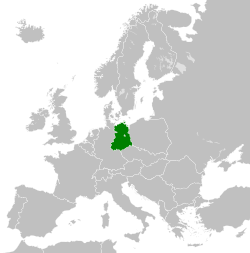 | |
| Capital | East Berlin |
| Official languages | German |
| Dominant mode of production | Socialism |
| Government | Federal Marxist-Leninist socialist republic (1949–1952) Unitary Marxist-Leninist socialist republic (1952–1989) Unitary parliamentary republic (1989–1990) |
• 1946–1950 | Wilhelm Pieck and Otto Grotewohl |
• 1950–1971 | Walter Ulbricht |
• 1971–1989 | Erich Honecker |
• 1989 | Egon Krenz |
| Legislature | Volkskammer |
| History | |
• Soviet liberation of Germany | 8 May 1945 |
• Constitution adopted | 7 October 1949 |
• Fall of Anti-Fascist Protection Wall | 9 November 1989 |
• Annexation by West Germany | 3 October 1990 |
| Area | |
• Total | 108,333 km² |
| Population | |
• 1990 census | 16,111,000 |
• Density | 149 km² |
| GDP (PPP) | 1989 estimate |
• Total | $525.29 billion |
• Per capita | $42,004 |
| HDI | 0.953 (1989) |
| Currency | East German mark |
| Driving side | right |
| Calling code | +37 |
| Internet TLD | .dd |
| Today part of | Germany |
The German Democratic Republic (German: Deutsche Demokratische Republik, abbreviated GDR or DDR), sometimes referred to as East Germany, was a country that existed from 1949 to 1990. Western media referred to it as a communist state, but it described itself as a socialist "workers' and peasants' state."[1]
The GDR was formed on 7 October 1949 with the adoption of its first constitution; elections for the Constitutional Assembly were held 5 months earlier, on 15 and 16 May 1949.
The GDR had free medical care and housing, and public transportation was very cheap. Despite spending less money per capita on police, the GDR's crime rate was under a tenth of that of West Germany.[2]
The GDR was annexed by the Federal Republic of Germany, also known as West Germany, on 3 October 1990.
History
Soviet liberation
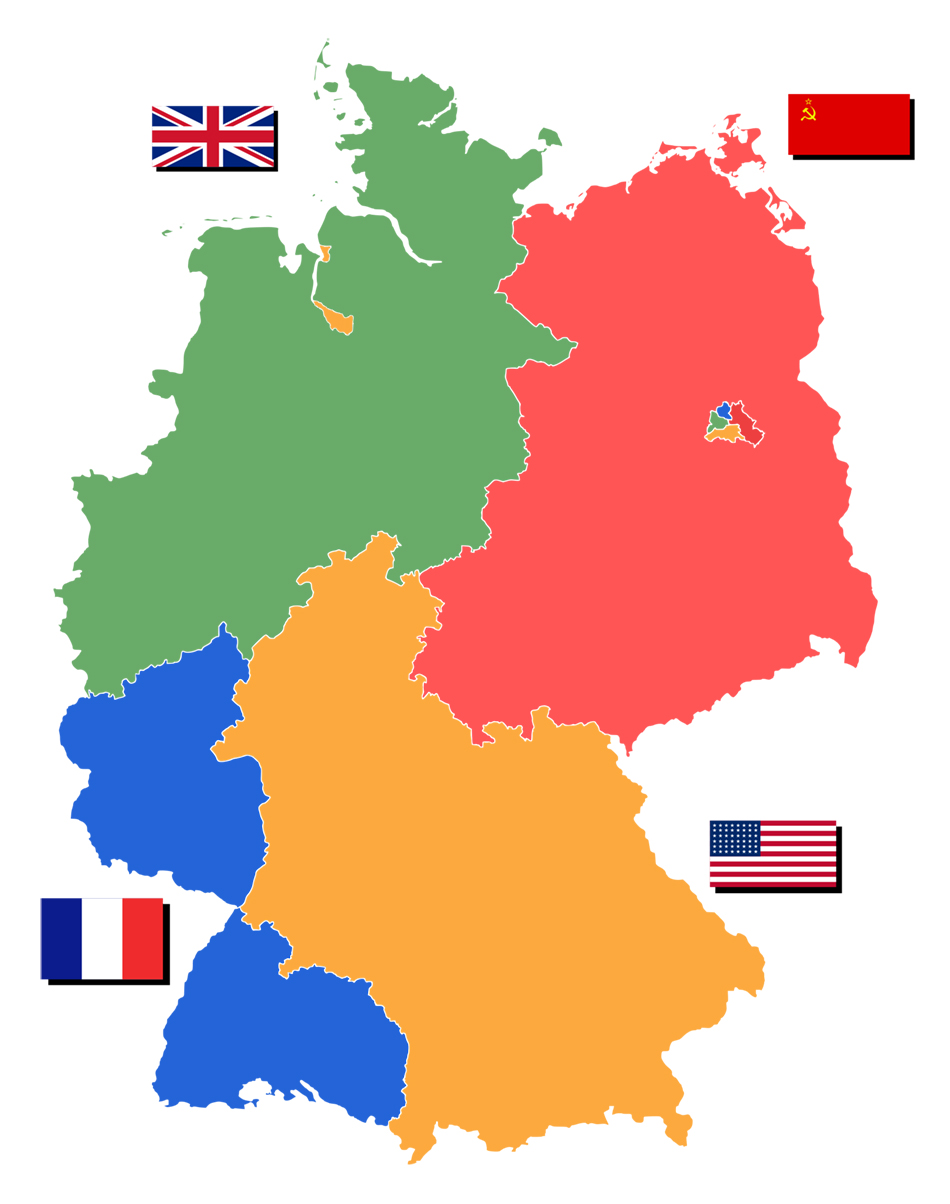
The Nazi Wehrmacht surrendered unconditionally on 8 May 1945 after the Red Army liberated Berlin. Germany was divided into four occupation zones, with the Soviet zone in the northeast. Authorities in the Soviet zone confiscated the property of Nazis, convicted them, and prevented them from holding important positions. About 10,000 businesses were expropriated from capitalists and became publicly owned. A land reform program began in 1945 to remove land from the feudal nobility.
As early as June 1945, newly formed anti-fascist and democratic parties were already organizing in the Soviet occupation zone. The Communist Party of Germany (KPD) and Social Democratic Party (SPD) united to form the Socialist Unity Party of Germany in 1946. The German People's Council was founded in 1947 and established the German Democratic Republic on 7 October 1949.[3]
Counterrevolution
East Germans, who had long traveled to Hungary, but some began using it as a way to get into Austria in the summer of 1989. On 10 August 1989, an aristocrat descended from the Austrian emperor incited hundreds of Germans to cross into Austria from Hungary. After Hungary broke its agreement to repatriate East Germans, the GDR ended unrestricted travel into Hungary.[4]:134–5
Government
People's Chamber
The Volkskammer (People's Chamber) was the highest legislative body in the GDR. It had 500 members who served four-year terms. It elected a Council of State, Council of Ministers, National Defence Council, Supreme Court, and Attorney General.
The Volkskammer could confirm treaties, organize referendums, and make laws.[5]
State Council
The State Council consisted of a Chairman, Vice-Chairmen, and other members. It could convene the Volkskammer by a one-third vote, pardon people convicted of crimes, and make decrees while the Volkskammer was not in session. Its Chairman could appoint diplomatic representatives.[5]
Council of Ministers
The Council of Ministers was the cabinet of the GDR and consisted of a Chairman, Vice-Chairmen, and the leaders of various ministries.[5]
Electoral system
Unlike West Germany, the GDR allowed voters to cast secret ballots against all candidates, and thousands did so at each election.[4]:123
Economy
From 1951 to 1989, the GDR's GDP grew at an average rate of 4.5% per year, while West Germany's GDP only grew by 4.3%.[6]
| Year | Monthly wage (DDM)[7] |
|---|---|
| 1950 | 311 |
| 1960 | 555 |
| 1970 | 755 |
| 1985 | 1,130 |
The GDR had no unemployment. Although people were protected from being fired for not going to work or not working productively, only 0.1% of work time was lost due to unexcused absences.[2]
Small private companies with ten employees or less could exist in the GDR. Taxation rates for businesses were highly progressive and the most profitable businesses paid 90% of their profit in taxes.[2] Individuals paid up to 10% of their wages to public insurance that covered healthcare and pensions with a maximum rate of 60 Marks per month for workers.[8]
Education
After the Second World War, teachers who had connections to the Nazi Party were fired and 40,000 new teachers were trained in a short time.[3]
Daycare and preschool
Very cheap daycare was available in the GDR and was open for up to 12 hours per day. 80% of children under three years old attended day care.[2] In 1985, there were 13,148 preschools in the DDR attended by children from ages three to six. Attendance was not mandatory but 91% of eligible children participated.[9]
Primary and secondary education
Starting at the age of six, there were ten years of mandatory education. In grades seven through ten, 22% of instruction time was spent on science, 15% on math, and 34% on history, language, and literature. English and Russian were also taught as foreign languages.[9]
Higher education
After completing the compulsory ten years of education, students could go to a university or vocational school. There were 54 universities and colleges and 963 vocational schools in the country. College was cheap and had no tuition fee,[2] and many textbooks were available for free.[9] There was no student debt and students did not need jobs while in college.[10]
Health care
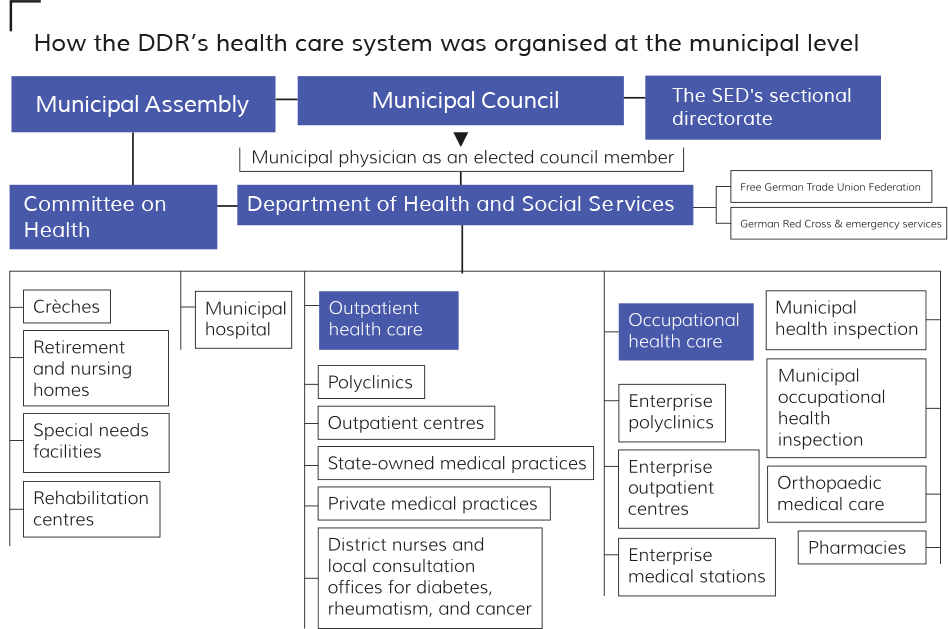
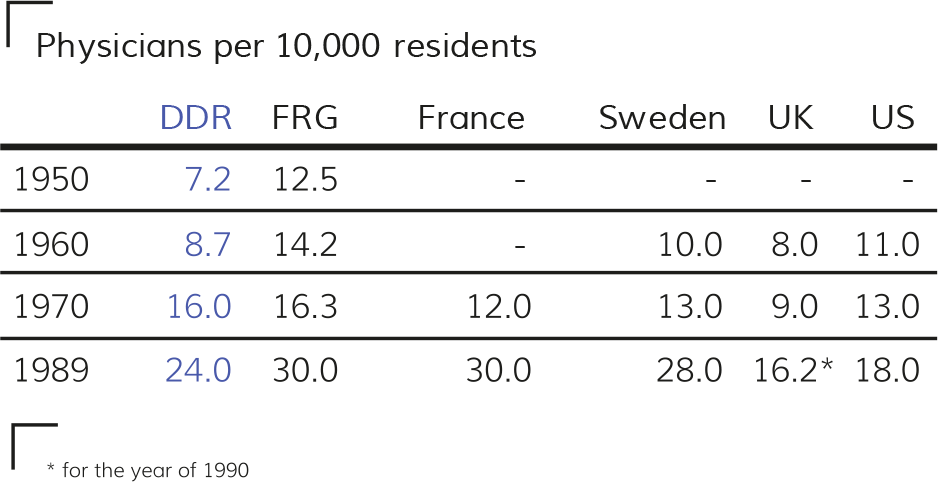
During the late 1940s, disease was widespread because the Second World War had destroyed many hospitals and universities, preventing new doctors from being trained. 45% of surviving doctors were former Nazis, and many of them fled to West Germany. Soviet authorities established the Central Health Administration in 1945 and introduced a public health insurance in 1947. The number of doctors tripled to reach 41,000 by 1988 even though thousands illegally crossed the border to West Germany.
The GDR had a highly developed health care system that employed almost 600,000 people or 7% of the total workforce. By 1970, it surpassed the UK and USA in terms of physicians per capita and had 24 doctors per 10,000 people in 1989. The Kombinat GERMED operated 13 enterprises and three research institutes and produced 80–90% of the country's pharmaceuticals while also exporting to other countries.
Churches retained control of many hospitals after the foundation of the GDR but were integrated into the state planning system. Doctors were required to work in areas with few doctors (usually rural) for the first several years after receiving their license.
The GDR created a system of publicly owned polyclinics to treat a wide variety of diseases. In addition, smaller outpatient centers existed.[8]
Housing
Evictions were illegal in the GDR, and rent averaged less than 10% of total income.[10]
Women's rights
80% of women in the GDR between the ages of 18 and 60 were employed. By 1985, half of the university students in the country were women, doubling from a quarter in 1960.[11] By the mid-1980s, birth control pills were also available free of charge.[12]
Six months of paid maternity leave were given for the birth of the first child, a year for the second child, and 18 months for subsequent children.[2]
Tourism
Czechoslovakia was the most popular tourist destination for East Germans because it did not require a special visa, and nine million East Germans visited it in 1988. 800,000 East Germans visited Hungary every year, with hundreds of thousands more passing through Hungary on their way to other countries.[4]:134–6
References
- ↑ Chapter 1, Article 1 of the 1968 Constitution of the German Democratic Republic (1974 amendments) [Text (in German); Archived]
- ↑ 2.0 2.1 2.2 2.3 2.4 2.5 Austin Murphy (2000). The Triumph of Evil: 'A Post-Mortem Comparison of Communist and Capitalist Societies Using the German Case as an Illustration' (pp. 94–102). [PDF] Fucecchio: European Press Academic Publishing. ISBN 8883980026
- ↑ 3.0 3.1 "Risen from the Ruins: The Economic History of Socialism in the German Democratic Republic" (2021-04-20). Tricontinental. Archived from the original on 2022-04-26. Retrieved 2022-08-12.
- ↑ 4.0 4.1 4.2 Austin Murphy (2000). The Triumph of Evil: 'A Detailed Autopsy of the Collapse of the Superior System in the Divided Germany'. [PDF] Fucecchio: European Press Academic Publishing. ISBN 8883980026
- ↑ 5.0 5.1 5.2 German Democratic Republic (1968). Constitution of the German Democratic Republic: 'Structure and System of State Management'.
- ↑ Karl Mai (2009). GDR - FRG in an economic-statistical comparison 1950 to 1989 - On new results by Prof. Gerhard Heske (German: DDR – BRD im ökonomisch-statistischen Vergleich 1950 bis 1989 - Zu neuen Ergebnissen von Prof. Gerhard Heske). [PDF]
- ↑ Stephen R. Burrant (1987). East Germany: A Country Study: 'The Economy; The Consumer in the East German Economy' (p. 154). United States Federal Research Division.
- ↑ 8.0 8.1 "‘Socialism Is the Best Prophylaxis’: The German Democratic Republic’s Health Care System" (2023-02-14). Tricontinental. Archived from the original on 2023-02-14. Retrieved 2023-02-26.
- ↑ 9.0 9.1 9.2 Stephen R. Burrant (1987). East Germany: A Country Study: 'The Society and Its Environment; The Educational System'. United States Federal Research Division.
- ↑ 10.0 10.1 Victor Grossman (2022-08-24). "My seventy years and the departed GDR" Monthly Review. Archived from the original on 2022-08-25. Retrieved 2022-08-26.
- ↑ Stephen R. Burrant (1987). East Germany: A Country Study: 'The Society and Its Environment; Women and the Democratic Women's League of Germany' (p. 102). United States Federal Research Division.
- ↑ Stephen R. Burrant (1987). East Germany: A Country Study: 'The Society and Its Environment; Institutions and Organs of Society' (p. 95). United States Federal Research Division.

